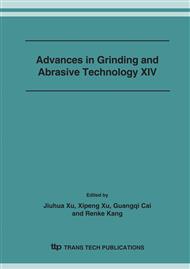p.489
p.494
p.499
p.504
p.509
p.513
p.518
p.523
p.528
Analysis and Simulation of Grinding Wheel Surface Topography
Abstract:
The topography of the grinding wheel has a profound effect in analysis and predicting the finished surface roughness. In this paper, the statistical analysis is applied to establish a distribution function of the grain protrusion heights, and the 3-D simulating topography of grinding wheel will be identified. Through experiments, the generated grinding wheel topography is effective in predicting the finished surface roughness.
Info:
Periodical:
Pages:
509-512
Citation:
Online since:
November 2007
Authors:
Keywords:
Price:
Сopyright:
© 2008 Trans Tech Publications Ltd. All Rights Reserved
Share:
Citation:


